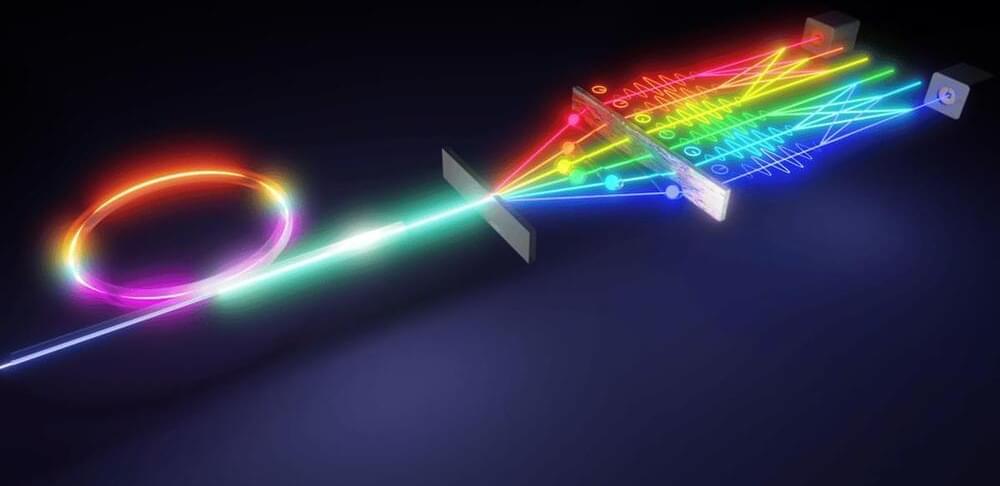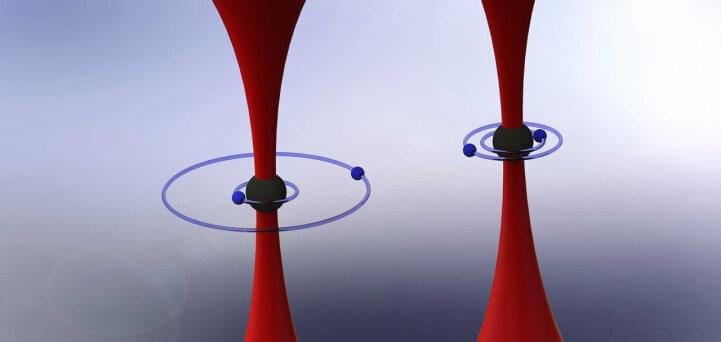In The Analysis of Matter (1927) Bertrand Russell defended a couple of theses that amounted to a novel approach to the mind-body problem. Similar claims were defended by Eddington in his Gifford lectures of the same year. This approach was forgotten about in the latter half of the twentieth century, perhaps because it didn’t fit with the physicalist predilections of the period. However, it has recently been rediscovered, leading to a view – or better a school of views – known as ‘Russellian monism.’ Russellian monism is increasingly seen as a promising middle way between dualism and physicalism, avoiding the problems associated with either of these extremes. In this lecture, I explain the basic idea.
Get the latest international news and world events from around the world.

“64-Dimensional Quantum Space” Drastically Boosts Quantum Computing
Scientists have demonstrated a powerful technique that will allow quantum computers to store much more information in photons of light. The team managed to encode eight levels of data into photons and read it back easily, representing an exponential leap over previous systems.
Traditional computers store and process information in binary bits, which can hold a value of zero or one. Quantum computers boost this power drastically with their quantum bits, or qubits, which can hold values of zero, one or both at the same time. But an emerging version of qubits, known as qudits, up the game even more. Rather than just two values like qubits, qudits can theoretically contain dozens of different values, greatly increasing the data processing and storage potential. Better yet, qudits are also more resilient against external noise that can disrupt qubits.
But, of course, there’s a catch: it’s hard to measure and read back data stored on qudits. So for the new study, researchers at Oak Ridge National Laboratory, Purdue University and EPFL have developed a technique to produce and read qudits more reliably. In their experiments, they generated qudits that could each hold up to eight levels of information, and quantum-entangled them in pairs to generate a 64-dimensional quantum space. This, the team says, is four times larger than in previous studies.


Physicists predict the novel entangled states on programmable quantum simulators
Quantum science has not only deepened human understanding of the structure of matter and its microscopic interactions, but also introduced a new paradigm of computing and information science—quantum computing and quantum simulation. Quantum informatics research has won the 2022 Nobel Prize in Physics.
Among many quantum computing and simulation platforms, Rydberg Atom Arrays is considered the most promising system to show quantum superiority among many programmable quantum simulator platforms in recent years due to its largest number of qubits and highest experimental accuracy.
Such optical lattices consist of individual neutral alkaline-earth atoms with significant dipole moments trapped in arrays of microscopic dipole traps, which can be optically moved at will to make desired lattice geometry. Each atom can be excited to its Rydberg state, and a pair of excited states interact through their dipole moments via a long-range interaction.

Differential patterns of cortical activation as a function of fluid reasoning complexity
Fluid intelligence (gf) refers to abstract reasoning and problem solving abilities. It is considered a human higher cognitive factor central to general intelligence (g). The regions of the cortex supporting gf have been revealed by recent bioimaging studies and valuable hypothesis on the neural correlates of individual differences have been proposed. However, little is known about the interaction between individual variability in gf and variation in cortical activity following task complexity increase. To further investigate this, two samples of participants (high-IQ, N = 8; low-IQ, N = 10) with significant differences in gf underwent two reasoning (moderate and complex) tasks and a control task adapted from the Raven progressive matrices. Functional magnetic resonance was used and the recorded signal analyzed between and within the groups. The present study revealed two opposite patterns of neural activity variation which were probably a reflection of the overall differences in cognitive resource modulation: when complexity increased, high-IQ subjects showed a signal enhancement in some frontal and parietal regions, whereas low-IQ subjects revealed a decreased activity in the same areas. Moreover, a direct comparison between the groups’ activation patterns revealed a greater neural activity in the low-IQ sample when conducting moderate task, with a strong involvement of medial and lateral frontal regions thus suggesting that the recruitment of executive functioning might be different between the groups. This study provides evidence for neural differences in facing reasoning complexity among subjects with different gf level that are mediated by specific patterns of activation of the underlying fronto-parietal network.

Distinct neural substrates for deductive and mathematical processing
In an effort to clarify how deductive reasoning is accomplished, an fMRI study was performed to observe the neural substrates of logical reasoning and mathematical calculation. Participants viewed a problem statement and three premises, and then either a conclusion or a mathematical formula. They had to indicate whether the conclusion followed from the premises, or to solve the mathematical formula. Language areas of the brain (Broca’s and Wernicke’s area) responded as the premises and the conclusion were read, but solution of the problems was then carried out by non-language areas. Regions in right prefrontal cortex and inferior parietal lobe were more active for reasoning than for calculation, whereas regions in left prefrontal cortex and superior parietal lobe were more active for calculation than for reasoning. In reasoning, only those problems calling for a search for counterexamples to conclusions recruited right frontal pole. These results have important implications for understanding how higher cognition, including deduction, is implemented in the brain. Different sorts of thinking recruit separate neural substrates, and logical reasoning goes beyond linguistic regions of the brain.


The neural basis of syllogistic reasoning: An event-related potential study
The spatiotemporal analysis of brain activation during syllogistic reasoning, and the execution of 1 baseline task (BST) were performed in 14 healthy adult participants using high-density event-related brain potentials (ERPs). The following results were obtained: First, the valid syllogistic reasoning task (VSR) elicited a greater positive ERP deflection than the invalid syllogistic reasoning task (ISR) and BST between 300 and 400 ms after the onset of the minor premise. Dipole source analysis of the difference waves (VSR-BST and VSR-ISR) indicated that the positive components were localized in the vicinity of the occipito-temporal cortex, possibly related to visual premise processing. Second, VSR and ISR demonstrated greater negativity than BST developed at 600–700 ms. Dipole source analysis of difference waves (VSR-BST and ISR-BST) indicated that the negative components were mainly localized near the medial frontal cortex/the anterior cingulate cortex, possibly related to the manipulation and integration of premise information. Third, both VSR and ISR elicited a more positive ERP deflection than BST between 2,500 and 3,000 ms. Voltage maps of the difference waves (VSR-BST and VSR-ISR) demonstrated strong activity in the right frontal scalp regions. Results indicate that the reasoning tasks may require more mental effort to spatial processing of working memory.

Working memory for order information: multiple cognitive and neural mechanisms
Working memory for order information is mediated by different cognitive mechanisms that rely on different neural circuits. Here we discuss evidence that order memory involves mechanisms that range from general supervisory processes to process that maintenance fine-grained temporal position information. We suggest that neural regions-including the prefrontal cortex, motor cortex, parietal cortex and medial temporal structures-operate at different levels and processing stages to give rise to working memory for order information.